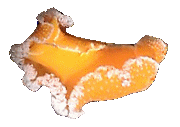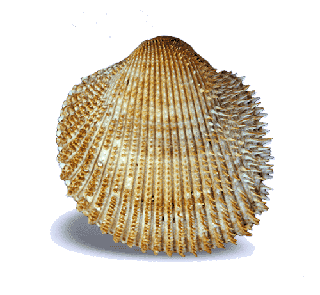Links
Commercially
Harvested
A= Aquaculture
Information
ANOMIIDAE
Jingle Shells
- Anomia ephippium (Linne, 1758)
Sea Hares
NOTE: Most sea hares should be concidered as poisonous due to their diet. However I have found an exception to this rule:
- There are a few noted exceptions: However, Before eating such a sea slug, I would be very careful to find out exactly how this slug should be prepared! For example, do they remove the skin & digestive gland first?
- Information on the aplysidae is gleamed from Bill Rudman's " SeaSlug Forum"
- Article of Interest: Boiled Sea-Slugs. Thes more than likely are sea cucumers and not seslugs.
Aplysia kurodai
(Baba, 1937)
- It seems that in some parts of Japan, sea slugs such as Aplysia kurodai have eaten for many years but not as a staple food. Apparently, it tastes like octopus.
- Dolabella auricularia
URL
URL
Women collect whatever they can find and boil them and cut them into pieces and then they are re-boiled in coconut milk. The viscera is eaten raw and marinated in lemon juice. It is usually mixed marinated together with the egg mass.
- Tochuina tetraquetra
(Dendronotacea)
(Pallas, 1788)
"Tochni"

URL
URL
- The Kuril Indians eat the species raw or cooked.
- North Pacific from Northern Japan, Kuril Islands (Russia), Alaska, Canada, and south to California
- One of the largest nudibranchs, growing to about 300mm long. Feeds on octocorals, including sea pens, gorgonians and softcorals
APORRHAIDAE
Pelican's Foot
- Aporrhais pespelicani
(Linne, 1758)
Common pelican's foot
- eaten in Adriatic
ARCIDAE
Arc Clams
-
URL Species list
- Anadara corbuloides (Monterosato, 1878)
Black Sea, Mediterranean
- Anadara
diluvii
(Lamarck, 1805)
Diluvial ark
- Andara granosa
(Linne 1758)
Granular ark , Blood cockle, Blood clam, Fr. Arche, Japan Akagai, Es. Pepitona
southeastern Asia; Indo-West Pacific.
URL
- Syn:
- Acra granosa
- Tegillarca granosa
- Preliminary Study on Suitable Environmental Conditions for Embryonic and Larval Development of Blood Clam Arca granosa
- Anadara inaequivalvis
(Bruguiere 1789)
Inequivalve ark, Es - Arca desigual; Fr - Arche inéquivalve
Japan, Italy,
Indo
Pacific
Indo-Pacific, introduced accidentally in the Adriatic in 1969
- Anadara subcrenata
(Lischke 1869)
Mogai clam, Half-crenate Ark, hen clam
- Arca imbricata
( Bruguiere 1789)
Mossy ark,
URL
- Arca noae
(Linnaeus, 1758)
Noah's ark, Japan: Noanohako
Yugoslavia
Also in the Atlantic of Portugal in Angola, Mediterranean; North West Africa.
Croatian cuisine
- Arca zebra
(Swainson 1833),
Atlantic turkey wing
- Barbatia barbata
(Linnaeus, 1758)
- Barbatia foliata (Forskal,1775)
File ark, Japan:Egai
- Scapharca broughtonii
URL
- Scapharca subcrenata
- Senilia senilis
(Linne 1758)
ARCTICIDAE
Arctica Clams
- Arctica islandica
ocean quahag, black clam, ocean clam
Norway, Newfoundland to North Carolina
- Quahogs are a favorite of New Englanders for chowders, clam sauces, and the obscure Rhode Island reference of clamcakes (though most prefer the little neck clam for this
- Clinocardium
nuttallii
(Conrad, 1837)
Nuttall's Cockle, Heart Cockle
Top Shells
Also see: TROCHIDAE
- Astraea (Lithopoma) undosa (Wood, 1828)
Wavy Turban;
Esp.: caracol panocha
- an edible species that is harvested for further canning process of the meat in north west Mexican Pacific coast (Ensenada). It is oriented for expot to asia and the local markets. Javier R.
- CITATION:
J. of Food Sci., Vol. 67, No. 4, 2002
Sensory and Texture Quality of Canned Whelk (Astraea undosa) Subjected to Tenderizing Treatments: AUTHOR(S): G.Y. Sanchez-Brambila, B.G. Lyon, Y.W. Huang, J.R. Franco Santiago, C.E. Lyon and K.W. Gates. - TEKTRAN
Frog Shells
- Bursa elegans
Bursa (Tutufa) elegans
(Sowerby I, 1835)
Elegant Frog Shell
URL
URL
BUCCINIDAE
Whelks
CARDIIDAE
Cockles

- Acanthocardia
aculeata
(Linnaeus, 1758, Linne 1767) - Syn: Cardium aculeatum (Linnaeus, 1758)
European Spiny Cockle, An - Spiny cockle; Es - Marolo; Fr - Bucarde aiguillonnée
The south from Norway to Morocco. The Mediterranean.
Italy
- Acanthocardia
echinata
(Linnaeus, 1758)
European Prickly Cockle, Es - Carneiro; Fr - Bucarde rouge
North from Norway and Iceland to Morocco and the Canary Islands. The Mediterranean.
France
-
Acanthocardiapaucicostata (Sowerby, 1839)
- Syn: Sphaerocardium paucicostatum (Sowerby, 1839)
Poorly ribbed cockle, Es - Gurriato; Fr - Bucarde peu costulée
-
Acanthocardia spinosa (Solander, 1786)
- Acanthocardia
tuberculata
(Linnaeus, 1758) - Syn: Cardium
tuberculatum (Linnaeus, 1758)
Rudicardium tuberculatum (Linnaeus, 1758)
Tuberculate cockle; Es - Corruco; Fr - Bucarde tuberculée
From Great Britain to Morocco and the Canary Islands. The Mediterranean.
France, Montinegro Coast
-
Cardites antiquatus (Linnaeus, 1758)
- Syn: Venericardia antiquata (Linnaeus, 1758)
URL
URL
Black Sea
- Cerastoderma
edule
(Linnaeus, 1758)
Common edible cockle; Es - Berberecho común; Fr - Coque commune
- Cerastoderma
glaucum
(Bruguière, 1789) - Syn: Cardium lamarcki Reeve, 1844
Common edible cockle,
Olive green cockle; Lagoon cockleEs - Berberecho verde; Fr - Coque glauque
All Europe, Spain, Black Sea
C
Croatian cuisine
-
Hypanis plicatus (Eichwald, 1829)
Black Sea
- Laevicardium crassum (Gmelin, 1791)
- Syn: Laevicardium
norvegicum (Spengler, 1799)
Black Sea
Other scientific names still of use: Laevicardium norvegicum (Spengler, 1799)
-
Laevicardium oblongum (Gmelin, 1791)
Black Sea, Straits of Gibraltar, Mediterranean
- Monodacna colorata (Eichwald, 1829)
brackish water in the lagoons and the mouth of the rivers at sea Noire and sea of Azov
Helmet Shells
- Information on the Cassidae Family from Worldwide Conchology
- Species List
- Cassidaria echinophora
(L., 1758)
Mediterranean Rugose (Spiny) Bonnet
- Cassidaria tyrrhena
(Chemnitz, 1789)
Rugose Bonnet, Es - Casco tirreno; Fr - Casque tyrrhénien
- Syn:
- Cassidaria rugosa (Linnaeus, 1766)
- Galeoda tyrrhena (Chemnitz, 1789)
- Spain: called Caracola, the soft parts of the mollusc are cut up into small pieces and broiled (AMG)
- Cassis cornuta
(Linneaeus, 1758)
Horned helmut, Yellow helmut
- edible but apparently very tough requiring a lot of pounding to tenderize it first
- "Cassis cornuta for eating??" Molluscan.com
- URL : Very beautiful photo series
- Cassis flammea
(Linnaeus, 1758)
Flame Helmet
- URL : Very beautiful photo series
- Cassis madagascariensis
(Lamarck, JBP, 1822)
Emperor Helmet;
King Conch
Japan: Kuchiguro- toukamuri
- Species is edible but apparently not consumed on a regular basis
- Cassis tuberosa
(Linnaeus, 1758) -
Caribbean Helmet; King helmut
- This is the most common of the true helmets in the Caribbean; however it is rarer site in Florida
- URL : Very beautiful photo series
- Phalium (Bezordicella)
saburon
(Bruguiere, 1792)
Saburon Bonnet
- URL : Great photo
- Phalium undulatum
??Semicassis granulata undulata
(Gmelin, JF, 1791),
Mediterranean Bonnet
CERITHS
- Species List: Hardy's Internet Guide
- Cerithium alucatrum
URL
URL
- common carithe (Gracilis elongata)
URL
URL
CHAMIDAE
Jewel Box Shells
- Chama macerophylla
Dove shells
- Colubella rustica
Cone Shells
- Conus gloriamaris
URL
URL
- Conus mediterraneus
- Conus planorbis
Jackknife Clams
- Ensis minor
- Ensis directus
- Pharus legumen
(Linnaeus, 1758)
bean solen
Tritons
Cowries
- Luria lurida
(C. Linnaeus, 1758)
- C. maculifera
(Schilder, 1932)
Reticulated Cowrie, Blotched Cowry
- eaten by the early Hawaiians
- C. Mauritiana
(Linnaeus, 1758)
Humpback cowrie
- eaten by the early Hawaiians
- C. Tigris schilderiana
- eaten by the
early Hawaiians. In
Hawaii they used to throw the
large Hawaiian tiger cowries into a beach bonfire and then crack the shells
to get the meat to eat. This evidence has been verified when searching old fire pits on the islands.